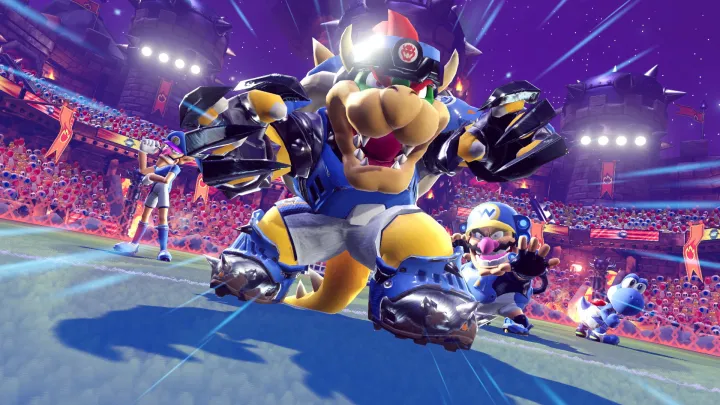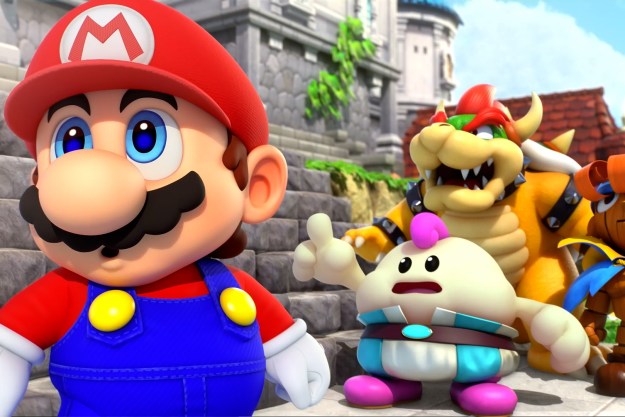Every time a Mario sports game has launched in the past decade, it’s seemingly been the same story. Players get a strong core experience anchored by highly refined sports gameplay. The problem? There aren’t a lot of compelling reasons to actually play due to thin feature lists. We saw it in Mario Tennis: Ultra Smash, Mario Sports Superstars, Mario Golf: Super Rush, and now again in Mario Strikers: Battle League.
The latter is arguably the most egregious offender yet. While it features some of the most complex and nuanced Mario sports gameplay to date, it’s severely lacking when it comes to game modes. Rather than including challenges and minigames to test players’ skill, there are three options: Freeplay, a small set of tournaments, and online play. All of those can be enjoyed solo, but it very much feels like a multiplayer-first experience built around its standout online “club” mode.
It’s a hard sell for a $60 game, but the problem might just be the format. Out of all Nintendo’s series, the Mario sports games could benefit from a more modern approach by adopting a free-to-play model. The trickier part is making sure that’s done the right way.
Less is fine
What’s funny about a game like Mario Strikers: Battle League is that it has just about as much content as other modern titles. It’s not unusual for a multiplayer-focused game to launch with one tight mode and expand on it later with updates. We already know that Battle League will get DLC, bringing more characters to the roster. The difference between that game and something like Apex Legends comes down to the initial buy-in.

Due to the nature of their $0 price tag, free-to-play games have much more flexibility than full retail ones. It doesn’t really matter how sparse the package is when players are downloading it for free. Successful free-to-play multiplayer games tend to hook players with an immediately fun experience upfront that feels like a steal and make their money later by selling bonuses (a tactic that some games tend to abuse).
By contrast, players expect a complete experience right out the gate if they’re paying full retail for a game — and that’s what Nintendo is currently struggling with. Recent Mario sports games (and even Nintendo Switch Sports) almost feel inspired by free-to-play design, putting more effort into creating strong online hooks that’ll keep players engaged. Extra content generally comes later, long after the average player will have moved on to the next hot game.
Take Mario Golf, for instance. Nintendo GameCube title Mario Golf: Toadstool Tour featured four primary solo modes, around a dozen multiplayer options, a handful of minigames, and unlockables for players to chase over the long-term. Last year’s Mario Golf: Super Rush launched as a much slimmer package with a quick story mode and three primary multiplayer options. It would add new features over time, but it was hard to shake the feeling that Nintendo missed the green with its release strategy.

If Nintendo is going to continue slimming down its multiplayer games in that way, a free-to-play pivot feels like a win-win move. It would allow the company to focus on creating strong multiplayer experiences that don’t need to launch with the wealth of content fans have come to expect from previous Mario sports titles or $60 games. Doing so would help games like Mario Strikers: Battle League find a broader audience that could be hooked into the game’s superior soccer systems through its club mode.
It would be an unprecedented move for Nintendo, but not for the industry at large. This month, both Knockout City and Fall Guys: Ultimate Knockout pivoted to a free-to-play model. Both games are excellent multiplayer titles that struggled to retain their audiences after being offered to players for free initially, but they sold in the long-term. The much bigger example is Halo Infinite, which went the free-to-play route with its multiplayer and sold its campaign separately. It continues to be a winning strategy for some of gaming’s most profitable franchises, so why shouldn’t Mario get in on the action too?
Nintendo’s cash cow
There’s an easy answer as to why Nintendo wouldn’t make a Mario game, sports or otherwise, free-to-play: They make too much money. Mario is a consistent cash cow for Nintendo, which can seemingly spin any game featuring the plumber into gold. If Nintendo did experiment with a free-to-play model, it would need to find a way to recoup what it would have made from simply launching a $60 game that it rarely ever discounts.
That’s where the downside of the business model comes into play. Free-to-play games have a bad rap with some players for their sometimes aggressive use of microtransactions. For every game that only charges for cosmetics, there’s another that veers uncomfortably close into pay-to-win territory, like Pokémon Unite.

Previous Nintendo attempts at free-to-play have been mixed when it comes to how successfully they’ve been monetized. There was the Wii U’s ill-fated Wii Sports Club, which charged users a daily fee to play. Other free Switch titles like Pokemon Quest and Super Kirby Clash haven’t exactly been big earners for Nintendo, though it’s found more success with Fire Emblem Heroes, a mobile game that employs “gacha” mechanics.
I imagine a free Mario sports game could charge players for new characters rather than giving them away for free, which seems reasonable, though there’s some potential danger too. Some Mario sports titles feature unlockable gear, like golf clubs, that can boost players’ stats. Locking those behind a paywall could be what cracks the thin ice the series is already standing on.
It’s risky, but a change of some form is in order. The Mario sports games have been in a steady decline since 2015 and Mario Strikers: Battle League’s lack of content is a troubling sign for the series’ future. A bold step into the free-to-play arena could allow Nintendo to stay competitive in a crowded modern scene and reclaim its position as the king of multiplayer.
Editors' Recommendations
- Paper Mario: The Thousand-Year Door remake is full of quality of life updates
- Super Mario Bros. Wonder almost featured a realistic Mario and surfing
- Mario vs. Donkey Kong remake’s new levels feel right at home
- Our favorite Switch games of 2023: Tears of the Kingdom, Mario, and much more
- The best video games of November 2023: Super Mario RPG, Assassin’s Creed Nexus, and more




